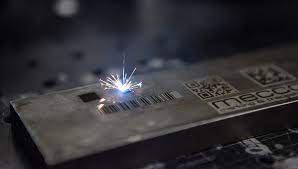Using lasers to mark parts or workpieces is an example of laser marking. The laser’s energy triggers a reaction on the material that leaves a permanent mark. Laser processes differ according to how fast, how powerful, and how focused the laser beam is on the part. Labeling can be done by laser engraving, laser etching, annealing, or laser ablation.
A successful marking process depends on selecting the right laser technology and configuration. Defining the requirements of your application areas is the first step to determining what you need. Some of these requirements include:
- Materials, sizes, and shapes of your parts
- Availability of your labeling time
- What is your production process?
Here are the factors that determine which laser system, power, and process is best for you.
Absorption spectra are present in all materials
Most industrial laser systems emit wavelengths that are invisible to the naked eye and therefore difficult to visualize. Different materials, however, react differently to wavelengths.
Various materials absorb certain wavelengths but not others due to their unique compositions. Using lasers to mark very special materials is highly specialized because they produce a single wavelength. Thus, each material has different requirements for the laser.
The type of laser system you need will depend on the material you are using.
Different wavelengths are generated by fiber lasers and CO2 lasers
Based on their gain medium – a component of the laser source – different types of laser emit different wavelengths. Based on the material to be marked, you will need a particular type of
laser marking system.
Marking metals with fiber lasers is the best method
Solid-state lasers are sometimes referred to as fiber lasers. An optical fiber is used for their laser source, which contains a rare metal like ytterbium. Lasers generate light with a wavelength of approximately 1 micrometer (1064 nm). Lasers work well on most metals.
Marking organic materials with gaseseous lasers is ideal
Laser systems that use gaseous sources have gaseous laser sources. CO2 lasers are the most well-known gas lasers. In laser marking, wavelengths can range from 9 micrometers to 10.2 micrometers (9,000-12,000 nm). This wavelength range is well suited for most organic compounds. As opposed to fiber lasers, metals do not react well to these wavelengths.
Each laser marking process has its own advantages and disadvantages
Depending on your application, you will need to select the right laser marking process. It may be necessary, for example, to create markings that cannot be removed. A special cycle time may require adaptation of the marking process.
It is important to know both your requirements and the production process before choosing the right laser process for you.
Laser engraving is used to create labels that are resistant to water
By breaking down parts of the material into dust, laser engraving makes deep indentations into a material. VIN markings are among the uses of laser engraving machines. In most cases, this involves a deep engraving, which ensures durability and prevents falsification. In addition, they can be used for markings that must withstand aggressive post-treatments, such as blasting.
High contrast, high speed marking is possible with laser etching
For laser marking to be integrated into a production line, laser etching is typically used when the laser marking process needs to run as quickly as possible. This technology causes the surface of the material to melt almost instantly, resulting in higher and flatter bumps. This results in high-contrast markings among other things.
The purpose of annexed markings is to protect materials that must not be damaged
This causes a chemical reaction below the surface of the material. There is no decomposition, displacement, or melting. The marking must not damage the surface of stainless steel, making it one of the few solutions for marking this material. Aesthetic applications of occasion lettering include logos. Even though it produces a more beautiful surface than other laser marking processes, it is slower.









![Anso FG Reviews: UPDATED 2024 [ansofg.com] Anso FG Reviews UPDATED 2024 [ansofg.com]](/wp-content/uploads/2023/12/Anso-FG-Reviews-UPDATED-2024-ansofg.com_-100x70.png)








